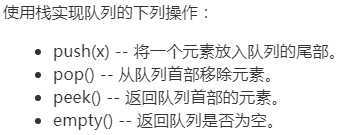


用两个栈:stackIn[] 和 stackOut[]分别模拟入队和出队;
注意:
出队时,只有当stackOut为空时才能将stackIn的元素入栈stackOut,且必须将stackIn的元素一次性全部转移到stackOut中,再出队。
进队时:只有当待入队元素全部进入stackIn后才能转移到stackOut,从而出队,且入队前若stackIn不为空则需等待。
class MyQueue(object):
# 初始化
def __init__(self):
"""
Initialize your data structure here.
"""
# 入栈,模拟进队
self.stackIn = []
# 出栈,模拟出队
self.stackOut = []
# 进队,本题似乎不用考虑stackIn不为空的情况,进队时默认stackIn为空
def push(self, x):
"""
Push element x to the back of queue.
:type x: int
:rtype: None
"""
self.stackIn.append(x)
# 出队
def pop(self):
"""
Removes the element from in front of queue and returns that element.
:rtype: int
"""
if not self.stackOut:
while self.stackIn:
self.stackOut.append(self.stackIn.pop())
return self.stackOut.pop()
else:
return self.stackOut.pop()
# 取队首元素
def peek(self):
"""
Get the front element.
:rtype: int
"""
if not self.stackOut:
while self.stackIn:
self.stackOut.append(self.stackIn.pop())
return self.stackOut[-1]
else:
return self.stackOut[-1]
# 队列判空:只有当stackIn和stackOut均为空时,队列为空。
def empty(self):
"""
Returns whether the queue is empty.
:rtype: bool
"""
return not self.stackIn and not self.stackOut
原文:https://www.cnblogs.com/panweiwei/p/12900185.html